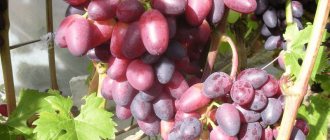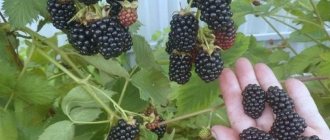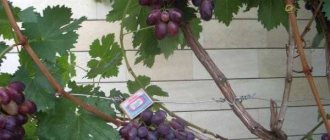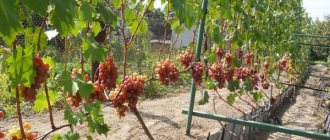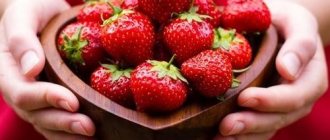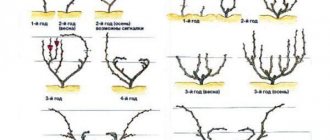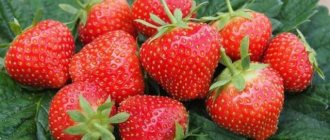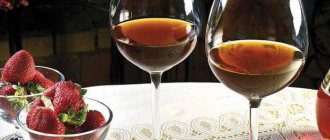- 2.1 Planting strawberries
The favorite of recent seasons has been the strawberry variety selected in Italy – Jolie. Having appeared ten years ago, this variety has not become very widespread and has not gained incredible popularity, but Jolie really deserves attention. This garden strawberry was developed as a productive variety with beautiful and even berries, ideal for sale. Jolie has a lot of advantages for which she is loved and appreciated not only by private summer residents and gardeners, but also by owners of large farms. Strawberries also have some disadvantages, which it is better to know about before purchasing and planting seedlings.
A detailed description of the Jolie strawberry variety, photos and reviews of those who have already planted it on their own plots can be found below. Here we will talk about the recommended planting of this garden strawberry and the care required for it.
Description of the variety
Bushes
Strong and large bushes are covered with abundant greenery with many bright green leaves. Three-lobed and corrugated, they give the plant a lush volume and an interesting decorative appearance. The flower stalks are also large and distinguished by their height and power.
The number of whiskers is significant, which avoids problems with the propagation of the variety. The root system has good survival rate, it is strong and viable.
Berries
Southerner Jolie performed especially well in the southern regions of Russia. When grown in the Krasnodar region, the berries are the largest and sweetest; the sour notes are very weak and practically not noticeable.
Characteristics of Jolie strawberries:
- conical shape of the fruit;
- weight 40-50 g;
- bright scarlet color;
- absence of voids inside;
- good storage;
- elasticity and dense consistency;
- high transportability.
Note: Berries placed in baskets are stored for a long time and do not wrinkle, remaining dry and fresh. Transportability and keeping quality served as the basis for the mass cultivation of the Jolie variety on an industrial scale.
Productivity
Strawberry Jolie belongs to the mid-early varieties. The berries are ready for picking in mid-June; the fruiting period is three weeks. Productivity - up to 1 kg. berries from the bush, which is not the maximum, but a very good indicator. There are European varieties that are characterized by higher yields, but Jolie gives a high yield of marketable products and this is its advantage.
Characteristics of this variety of garden strawberries:
— Strawberries are mid-season, the ripening period of the berries begins in the first week of the first summer month. And the parent variety “Clery” ripens one week earlier.
— In appearance, this variety can be spawned with the parent variety “Clery”. They are both highly branched and tall.
— The foliage is large in size, the surface reflects the glare of the sun, and has a slight downward slope.
— The amount of foliage is large.
— Under the foliage there are flower stalks, they are dense and large in size.
— This variety is bred using the mustache that the bush produces.
— The roots are very strong, well developed, this contributes to high levels of resistance to adverse weather conditions and long life. It takes root well in the ground in a short time.
— The fruits are large in size, the shape resembles a regular cone.
— All berries have approximately the same appearance, namely color, shape, size. Their mass is twenty to thirty-five grams.
— The fruits become smaller in size towards the end of the berry bearing process.
— The color of the berries is red, the surface reflects the glare of the sun, and yellow seeds are located throughout the strawberries.
— We can say that the berries have almost no neck; at the moment of technical ripeness, it has a snow-white or green color.
— At the moment of final ripening, the fruits have a bright red color.
— The density of the pulp of the fruit is high, filled with juice.
— The taste is amazing, sweet and at the same time sour berry, pleasant berry smell.
— This variety is classified as dessert.
— This variety tolerates long-term transportation well, but its shelf life is short.
— When defrosting, the berries do not melt or become deformed.
— Has a high level of resistance to various diseases, for example, root rot.
— It has a large amount of harvest, usually eight hundred to nine hundred grams, and sometimes a whole kilogram, can be collected from one bush.
The productive qualities of this variety of garden strawberry come from the climate and area in which it grows. However, in any conditions it brings a large amount of tasty harvest.
a brief description of
Advantages of the variety
- above-average yields;
- aligned large berries;
- resistance to most diseases;
- good adaptation and resistance to drought;
- simple propagation and high survival rate of young bushes;
- ease of care.
Disadvantages of the variety
- yield fluctuations related to climate and soil conditions;
- the need for abundant fertilizing on poor soils;
- low winter hardiness.
Note: Due to its good adaptation and drought resistance, the variety is successfully cultivated in the southern regions of Russia and is already gaining popularity among gardeners in the Krasnodar region.
Pros and cons of the Jolie variety
Like any variety, Jolie strawberries have a large number of positive qualities. These include:
- high productivity;
- early ripeness;
- large fruits of high quality;
- immunity to diseases and drought resistance;
- good transportability and long shelf life;
- ease of reproduction and good survival rate.
The disadvantages many summer residents include:
- productivity decreases with sudden changes in temperature;
- low location of the peduncle, the ripe berry comes into contact with the ground, which can lead to rot;
- When grown on infertile soils, the taste is significantly reduced.
Landing
It is important to initially choose the right landing site. A mistake at this stage may result in the need for subsequent replanting or the death of the bush. Strawberry Jolie is best suited for:
- bright, sunny areas that warm up well;
- absence of wind and drafts;
- dry places without excessive moisture;
- neutral soils (acidic soil must be limed).
The ideal time for planting is early spring or early autumn. During these periods, optimal conditions are created for the survival of seedlings and their adaptation to new conditions. On the eve of planting, the site is prepared, dug up and organic fertilizers are applied. Dig holes every 30 cm, maintaining row spacing at 60-70 cm, and also choose the method of placing seedlings - strip or in a checkerboard pattern.
Rotted manure, peat, and ash are added to the holes. Before planting, the soil is watered and the seedlings are planted, carefully straightening the roots. When purchasing seedlings with a closed root system, both planting and survival are greatly facilitated. The seedlings are buried to the growth point, the ground is compacted and mulched with peat, straw, and sawdust.
Advice! Before planting, the root system must be carefully checked, removing too long or diseased roots. On the eve of planting, the roots are kept for 2-3 hours in water or Kornevin solution for better survival.
Rules for caring for strawberries
Despite the unpretentiousness of the variety, it needs to be looked after. In general, Jolie garden strawberries need timely watering and periodic fertilizing.
Jolie is a moisture-loving variety, but it does not tolerate stagnant water very well, in general, like any other strawberry. For this reason, experienced gardeners recommend using a drip irrigation system.
The frequency of watering strawberries depends on the growing climatic conditions. You need to make sure that the soil is not too dry.
Typically, strawberries are watered once a week. If there is extreme heat, then the number of waterings is increased to 2-3 per week.
Fertilize strawberries three times per season:
- The first time in the spring, so that the bushes wake up from winter sleep. In spring, it is advisable to use nitrogen-containing fertilizers. They stimulate the growth of the green part of the crop.
- The second time when the ovaries are forming. During this growing season, the crop needs phosphorus-potassium supplements.
- The last time Jolie needs to be fertilized is after harvesting, in order to prepare the plant for winter sleep. Fertilize strawberries in the fall with organic fertilizers.
We also recommend reading: Description of the Malvina strawberry variety
Growing and care
Watering
Jolie strawberries are drought-resistant varieties and can withstand long periods of drought with virtually no loss in fruit size. However, with timely watering, preferably with warm, settled water, the berries will be fleshier and the yield will be much higher. Watering is carried out as the soil dries. Drip irrigation is convenient, which automates work and well wets the soil to a sufficient depth. When watering, you need to take into account that strawberries are prone to root rot, so you should not overwater the bushes.
Irrigation is recommended throughout the growing season and even in the fall, when moisture-recharging watering is carried out, which is necessary for the plant to overwinter better. Moist soil will better protect the roots from frost.
Loosening, weed control
Loosening and weed control are among the necessary agrotechnical practices necessary for the normal growth and development of strawberry bushes. During the loosening process, weeds are removed, which thicken the plantings and reduce yields. Deep loosening is unacceptable, since the Jolie root system is located superficially and can be damaged.
Removing a mustache
Removal of whiskers is carried out from the very beginning of summer until autumn, when the removal of whiskers and leaves is part of the work to prepare bushes for the winter period. The mustache is not torn off, but carefully cut off using scissors or pruning shears. The abundance of runners reduces the yield and size of berries, since nutrients are spent on additional shoot growth.
Top dressing
Italian Jolie is demanding of fertile soils, so she needs periodic abundant fertilizing:
- in the spring, for the growth of green mass, urea is added to the soil;
- in summer, during the fruiting period, complex mixtures are useful: Ammofoska, Fertik or Kemira;
- After harvesting, a potassium-phosphorus compound is added to the soil.
Tip: In poor soils, fertilization is extremely important. Without timely fertilizing, productivity decreases and the risk of developing chlorosis increases.
Pest and disease control
The most common pests found on strawberries are aphids and strawberry mites. Bordeaux mixture helps to cope with colonies of “enemies”. In case of severe infection, some of the bushes are removed. Don't mind eating sweet berries and slugs. They get rid of them by creating traps, pollinating the leaves with ash or tobacco.
Among the diseases, Jolie strawberries are affected by gray rot and brown spot. As a preventive measure, you need to ensure that the plantings are not thickened and do not add nitrogen components in excess of the norm. In case of severe damage, treatment with chemicals is inevitable.
Advice: After harvesting, it is advisable to mow the leaves and treat Jolie with Fitoverm three times. By the end of summer, the bushes will recover and lay new buds.
Preparing for winter
In autumn, the bushes need to be cleared of weeds, the tendrils and old foliage removed, leaving a growth bud and 3-4 young leaves. In the southern regions there is no need for shelter, but in the middle zone strawberries are mulched, covered with leaves, spruce branches and agrofibre. In the northern regions there is a high risk of the variety freezing.
Note: Some farmers grow the Jolie variety in film tunnels, where it overwinters well and begins to bear fruit earlier than stated.
Pests and diseases
The variety has fairly strong immunity, for example, even in unfavorable growing conditions it is very rarely affected by root rot, verticillium and anthracnose. However, a number of diseases can still “mow down” Italian garden strawberries.
The main parasites that Jolie may encounter:
- Aphid. These small parasites suck out all the vital juices from the plant. In addition to being pests themselves, they also attract black garden ants to the site, which use aphids as their livestock. You can fight aphids in many ways, including special insecticides, Bordeaux mixture or garlic infusion.
- Strawberry mite. A harmful parasite that very often invades crops. You can fight strawberry mites using the same methods as aphids.
- Slugs. These parasites are active mainly at night. To combat slugs, dry mustard, ash, salt and beer traps are used. You can also mulch the beds to prevent the appearance of this parasite on the site.
Reproduction
Young seedlings are obtained by separating the tendrils from the mother plant. To form a mother plant, several Jolie bushes are planted separately, allowing them to grow mustaches. The mustaches of fruit-bearing bushes are cut out.
The following signs indicate that the whiskers are ready for planting:
- three formed leaves;
- the presence of several roots;
- healthy appearance.
Transplanted plants quickly take root and, in the case of autumn planting, begin to bear fruit the following summer.
Advice: For weak bushes, it is better to remove the first flower buds so that they become stronger and begin to grow, first of all gaining green mass. In the future, fruiting will be full and more abundant.
How to care for a plant?
In order for strawberries to develop well and bear fruit abundantly, they should be provided with complete and high-quality care.
What to feed?
To feed the bushes it is worth using mineral complexes. Such fertilizers are applied during flowering and fruit formation. If you neglect this procedure, there is a risk of developing a dangerous disease - chlorosis. In autumn it is worth using organic fertilizers. These include humus, bird droppings, and mullein.
How to water?
Strawberries of this variety are considered a moisture-loving plant. However, overwatering is dangerous for the plant. Therefore, experts advise using a drip irrigation system. 1 square meter will require 10 liters of water.
Mulching and loosening
The plant needs light and loose soil that allows air to pass through well. Therefore, after each watering, the bed should be loosened. This will help prevent crusting. Before flowering, plants should be hilled. It is recommended to do this three times a week. During harvest, the procedure is performed at intervals of 2 weeks. It is recommended to cultivate the soil to a depth of 4 centimeters.
To retain moisture, prevent the active development of weeds and protect the roots from aggressive sun, mulch the soil.
For this, it is recommended to use sawdust or straw.
Preparing for winter
To avoid the development of fungal infections, in the fall it is worth clearing the bed of dry leaves. To stimulate the formation of tendrils, it is recommended to separate the uterine bushes. The remaining tendrils should be removed, as they can lead to a decrease in yield.
In regions with snowy winters and minor frosts, strawberries are not covered. In other cases, the plant is insulated with straw, film or agrofibre.
Reviews
"Jolie" is one of my favorite varieties. The berries are simply huge and they do not shrink even during the last harvest. It tastes sweet, and in terms of ripening time it comes a week after Honey and Clery. It’s stable, I haven’t had any pain, I treat it with Falcon and Ridomil for prevention. I only have rotted manure for feeding.
Last year the weather was very rainy and the strawberries tasted bad. The aroma and sweet notes remained only with Syria and Jolie. Syria was sweeter, but Jolie was pleased with the size of the berries.
The Italian variety Jolie can take its rightful place in the collection of experienced gardeners who can appreciate the size and taste of its fruits. Summer residents of the northern regions are deprived of this opportunity, since the “southerner” is capricious and does not like the cold Russian winters.
We collect and store the harvest
To collect berries, it is good to prepare a container that is not too deep. Although the fruits of the Jolie variety do not wrinkle much, it is advisable to collect and transport them in small containers. The best time for such a pleasant job as harvesting strawberries is morning and evening.
The shelf life of fresh berries in the refrigerator is up to 6 days. If you need to stock up on strawberries for a longer period, you need to freeze them and store them in the freezer. The berries must first be peeled and dried thoroughly.
The secret to rich harvests of Jolie strawberries is a careful study of the characteristics of the variety and compliance with the rules of agricultural technology. If the weather is good, you can pick berries from the beds starting in mid-June for 3 weeks. The collected fruits are enough both to get a boost of vitamins with fresh produce and to prepare for the winter.

